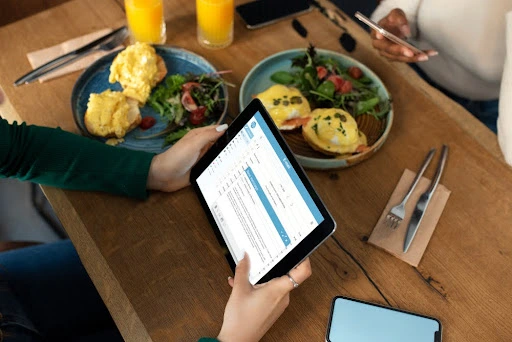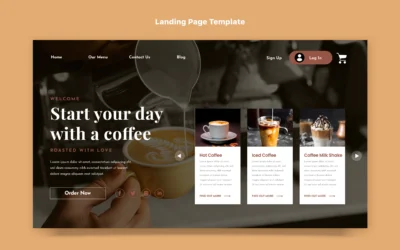An all-in-one restaurant operating system combines essential tools into a single platform, streamlining everything from taking orders to managing inventory. This integrated system allows different aspects of your restaurant to ‘talk’ to each other, eliminating errors caused by manual data transfer and providing valuable insights to help you make better decisions.
How the Different Components of a Restaurant System Achieve Best Results?
Don’t fall for the myth that only large restaurants need tech! An all-in-one system offers benefits for establishments of all sizes. By automating tasks, reducing errors, and providing data on your operations, these systems give you insights and time back – crucial advantages for any restaurant.
Statistical data shows that restaurants that effectively utilize integrated management systems experience significant improvements in revenue and customer retention. Solutions such as cloud-based platforms offer scalability and flexibility, allowing for easy customization and adaptability to changing market trends. By debunking the myth that these systems are overly complex or unnecessary, restaurant operators can unlock the full potential of their business and create a more streamlined and customer-centric dining experience.
Key Components of a Modern Restaurant Tech Stack
The heart of your restaurant tech, your POS goes beyond just payments. Look for systems that integrate with inventory, reservations, and other tools for a seamless experience.
Delivery tech
The rise of third-party delivery platforms post-COVID-19 has emphasized the need for efficient order management and delivery processes in restaurants. Major players like DoorDash, Postmates, Uber Eats, and others offer sales platforms and delivery services, but integrating multiple partners can be challenging for restaurants, leading to operational inefficiencies. Integrators like Milagro streamline this process by integrating various delivery services into a single platform, ensuring orders flow directly to the POS and kitchen consistently. By utilizing aggregators, restaurants can manage menu changes centrally and optimize operations across multiple delivery partners for increased efficiency and profitability.
Inventory management tools
Inventory management systems streamline restaurant stock management processes, automating tasks to reduce errors, minimize waste, and optimize ordering. Integrating these systems with the POS enhances data flow between front and back-of-house operations, offering a comprehensive view of stock levels, costs, and ordering requirements.
Online reservation systems
Online reservation systems are increasingly common in restaurants, providing customers with the convenience of viewing available slots and booking directly. These digital systems offer useful features for front-of-house staff, such as visual interfaces for table and waitlist management. By integrating with the POS system, staff can add reservation notes and guest details to enhance the guest experience. Collecting customer data through reservation systems is crucial for personalization and loyalty-building strategies, allowing restaurants to offer tailored promotions and services. Top reservation systems like SmartWAIT, Sevenrooms, Opentable, and TableUp emphasize enhancing customer experience and leveraging customer data for marketing purposes, often incorporating CRM systems and marketing tools.
Takeaway, click and collect, and mobile order-ahead tech
Restaurants can enhance their operations with takeaway, click-and-collect, and mobile order-ahead technologies. Platforms like Flipdish, Innovorder, and Slerp assist restaurants in creating their ordering apps and delivery systems. Major chains like Starbucks, Domino’s, and Dunkin utilize mobile order-ahead technology to offer customers convenient mobile ordering experiences. The trend of mobile ordering from the table while dining in is gaining traction, allowing customers to place orders directly from their phones by scanning a QR code at the table.
Analytics and Reporting
Utilizing data analytics is essential in the digital era to enhance business systems and processes. Top system providers, including POS providers, reservation systems, and delivery aggregators like Milagro, offer integrated analytics and reporting tools either internally or through seamless third-party integration, tailored to their respective operational domains.
Integrations with other tech solutions
Integrations play a vital role in building a comprehensive restaurant tech stack. As no single system can cover all needs, leveraging integrations is essential to optimize operations. Evaluating systems with existing integrations allows restaurants to choose solutions that align with their requirements and complement their current setup. The collaboration among top tech companies to integrate is increasing, paving the way for enhanced industry-wide interoperability. Integrations not only support current needs but also prepare restaurants for future technological advancements like robotic kitchens, increased AI utilization, and last-mile drone delivery.
Restaurant Tech in 2024: Trends + Why It’s Important
In the year 2024, it is fascinating to delve into the trends shaping the restaurant industry. Post-pandemic, we witness a dynamic evolution driven by cutting-edge technologies such as advanced data analytics and AI solutions.
- Easy and frictionless digital ordering and payment processes are crucial as they enhance convenience for customers, leading to increased sales and improved customer satisfaction.
- Data analysis is essential for smarter food service as it provides valuable insights into customer preferences, operational efficiency, and market trends. This data-driven approach enables restaurants to make informed decisions that can optimize their offerings and enhance profitability.
- The off-premises dining demand is expected to continue growing as consumers seek convenience and flexibility in how they access restaurant meals. Restaurants need to adapt to this trend by offering efficient delivery and takeout options to meet the evolving needs of their customers.
- Implementing improved customer loyalty and engagement technologies is vital for building long-term relationships with customers. By personalizing interactions, rewarding loyalty, and fostering engagement through various channels, restaurants can create a loyal customer base that drives repeat business and positive word-of-mouth.
- The diversification of ghost kitchens and virtual restaurants provides opportunities for restaurants to expand their reach, test new concepts, and cater to different customer segments without the overhead costs of traditional brick-and-mortar establishments. This diversification strategy can help restaurants stay competitive in a rapidly changing market landscape.
- The metaverse offers exciting yet untested opportunities for the restaurant industry to create immersive and interactive dining experiences in virtual environments. By exploring virtual reality, augmented reality, and other metaverse technologies, restaurants can engage customers in innovative ways and differentiate themselves in a crowded marketplace.
- Embracing automation and AI use cases for drive-thrus and beyond can revolutionize the efficiency and customer experience in restaurant operations. By automating repetitive tasks, streamlining workflows, and leveraging AI technologies for personalized service, restaurants can improve the speed of service, accuracy, and overall satisfaction for customers dining in-store or using drive-thru facilities.
Benefits of an All-in-One Restaurant Platform
A restaurant platform offers a comprehensive solution to a restaurant’s technological requirements through a unified hardware and software interface, and the advantages of an all-in-one platform can be significant.
Enhanced Guest Experience
Milagro’s all-in-one platform delivers exceptional technology-driven dining experiences for both on-site and off-site dining, along with robust guest marketing and loyalty programs to encourage repeat visits.
- Integrated online ordering, delivery, and contactless payment solutions empower guests to place orders according to their preferences.
- Milagro Order & Pay provides guests with more control over their dining experience, resulting in a 12% increase in check sizes.
- Milagro’s Marketing and Loyalty solutions utilize data from the entire Milagro platform to enhance guest retention.
Improved Operational Efficiency
Milagro integrates front-of-house, back-of-house, and management technologies to significantly streamline restaurant operations.
- Round-the-clock customer support and high reliability ensure assistance is available at all times.
- Direct integrations with third-party delivery providers enable restaurants to manage all orders through a single, user-friendly interface, eliminating the need for multiple tablets, menus, or redundant data entry.
- Milagro’s Kitchen Display System enables real-time order processing and response in the kitchen.
Better for Employees
Milagro simplifies restaurant operations and management, enhancing employee productivity and improving the overall employee experience.
- The handheld devices and contactless payment technology from Milagro enable staff to serve guests more efficiently, leading to a potential increase of up to 30% in orders served during peak hours.
- The use of handhelds and Order & Pay technology reduces the need for staff to constantly return to the POS system throughout their shifts, minimizing the number of steps they need to take per shift.
- Milagro’s integrated payroll solution leverages point-of-sale data to streamline payroll processes, reducing the time spent on payroll to an average of 20 minutes or less.
Better for Business
By enhancing guest, operational, and employee experiences, Milagro’s all-in-one restaurant platform can significantly impact your restaurant’s revenue and profitability.
- Restaurants that utilized Milagro’s All-In-One Platform during the pandemic experienced sales increases of up to 30% compared to those using only Milagro Point of Sale.
- Milagro Delivery Services enable restaurants to offer greater convenience to guests while reducing commissions paid to third-party delivery services. Milagro customers were charged up to 30% commission charged by third-party delivery providers.
Stay Ahead of Competitors with Proactive Strategies
Whether you are interested in metaverse opportunities or concentrating on creating a database of customer profiles for marketing, a clear trend emerges – clean, first-party customer data is crucial for sustained growth. To maximize the advantages of new technologies, it is vital to have ownership of your customer data. This emphasizes the importance of directing customers to your ordering platforms and providing exceptional customer service. This approach not only enhances customer engagement through cutting-edge technology but also facilitates quicker identification of future trends and prediction of potential outcomes in an unpredictable future.





